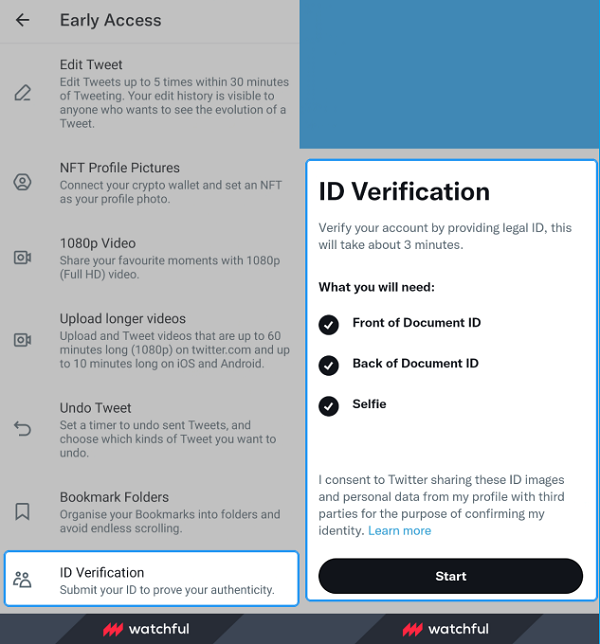Twitter could be close to adding a crucial layer of authentication to its Twitter Blue sign-up process, which would ensure that the person signing up for a Twitter Blue verified account is actually a real person, with a real identity linked to their platform presence.
According to TechCrunch, Twitter is currently testing the new ID verification element, which would be tied to the Twitter Blue sign-up process.

As you can see in these images (shared by Watchful.ai), Twitter’s looking to integrate ID verification into its Twitter Blue options.
As per TechCrunch:
“Code-level insights reveal a process for sending in a photo of the user’s ID, both front and back, along with a selfie photo to verify their Twitter account. The feature is listed alongside others only available to Twitter Blue subscribers.”
ID verification was flagged as a key element in Twitter’s revised Twitter Blue sign-up process back in December, after the initial launch of Twitter’s buyable checkmark system led to a raft of impersonation issues.
But Twitter didn’t actually implement ID verification within its new process, opting instead to hasten the rollout, in order to maximize revenue intake from the scheme. But now, Twitter appears to be looking to reintegrate verification into the process, which would help to ensure that all users who sign up to Twitter Blue, and get a checkmark in the app, are real people, with full address information and contact data, which could go a long way towards addressing abuse of the system by bots and scammers.
Which is one of the key aims of the process. As Twitter chief Elon Musk notes:
“Verified accounts are 1000X harder to game by bot & troll armies.”
That’s true, but there does also need to be a level of checking involved in the process, as ‘payment verification’, as Twitter calls it, will only go so far as a deterrent in the sign-up process.
Indeed, already many unsavory types are signing up for verified Twitter accounts through the program, including members of the Taliban and Mexican drug cartels. The blue checkmark gives these accounts an extra level of legitimacy, at least on some level, and it would seem that more stringent ID checking would weed out some of these potential issues – not to mention that bot scammers are also still able to buy checkmark accounts, and use them for ill purpose.
The view is that paying $8 makes this cost prohibitive, but that depends on how much the scammers make out of their grift. If the average return is greater than $8 – which evidence suggests it is – then it’s likely not the barrier that Twitter seems to think.
But then again, maybe that’s why it’s now looking to implement ID verification, to close this loophole, and continue to up its defenses against such, while also facilitating an additional revenue stream.
Twitter Blue remains a key element of Elon Musk’s ‘Twitter 2.0’ reformation push, with Musk hoping to use subscription revenue to reduce the app’s reliance on ad intake, and thus also enable it to operate without having to factor in advertiser concerns in its decisions.
That could help Musk move more towards his ‘free speech’ ethos for the app, as reduced reliance on ad dollars would mean Twitter could allow more types of speech, without impacting overall revenue – but thus far, Twitter Blue sign-ups have been well down on what Musk and Co. need to make it a key revenue consideration.
Based on the most recent analysis, Twitter Blue now has around 450k sign-ups, after the program was expanded to more regions over the past few weeks. At 450k users paying $8 per month, that’s an extra $3.6 million per month coming into Twitter’s coffers, or $10.8 million per quarter. Which is a significant amount – but Twitter’s advertising intake in Q2 2022, the last time it publicly reported its numbers, was $1.18 billion. That means that Twitter Blue would need to be bringing in around $590 million per quarter to meet Musk’s previously stated goal of it contributing 50% of the company’s overall revenue.
So it’s a way off being what Elon had hoped – though even at moderate levels, it’s bringing in money when Twitter desperately needs it, with, reportedly, 70 of the platform’s top 100 advertisers not resuming full spend at the app since Musk took over.
As such, Twitter Blue will likely remain a focus, but the likelihood of it becoming a significant contributor to Twitter’s overall intake seems low.
But at the same time, lower levels of intake would make something like ID verification easier to facilitate. Maybe, that’s the silver lining here, and with improved verification, that could make Twitter Blue a more effective tool for combating bots, even if it’s not a huge money maker, in relative terms.



